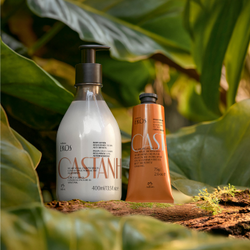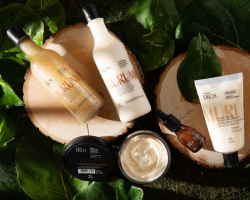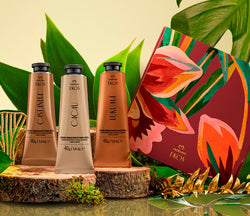beauty
Massaging strengthens the bond between you and your baby
Shantala step by step: enjoy this relaxing massage with your baby.
- By Natura Team
Shantala originated in India and carries well-being all over the world. Since the launch of its Mamãe e Bebê line in 1993, Natura has believed in this massage as a way of strengthening bonds. The babies that receive the massage sleep and breathe better and enjoy a closer relationship with the person giving it. Moreover, the movements in baby’s abdominal region help eliminate gases and reduce the unpleasant colic pains that are so common in the first months of life.
This is an ancient technique. It was developed in India and disseminated worldwide by the French obstetrician Frédérick Leboyer in the 1970s. Up until today, it is considered to be a therapy that induces well being both for the recipient of the massage and the person performing it.
Diverse studies also report other benefits derived from Shantala, such as the strengthening of the immunological system, improved digestion and the stimulation of the lymphatic and circulatory systems. Some people say that the massage facilitates breast feeding, alleviates stress and also activates the production of endorphins, which are neurotransmitters responsible for the feelings of happiness and well-being.
We have prepared some tips to make this ritual very pleasurable for you and your baby.
Preparation
- Make sure you have enough time to perform the ritual without hurrying. This will permit you to enjoy every movement and banish anxiety.
- Do not perform the massage soon after breast feeding. The baby should not have been fed in the last hour.
- If it is cold, warm up the location where the Shantala will be performed.
- Cover the floor where you will sit with a mat (gymnastics) or duvet. Since the position (legs stretched and backbone erect) might not be very comfortable, use cushions to support your back.
- Wear comfortable clothes.
- Remove any rings and bracelets and wash your hands well.
- Have a bottle of vegetable oil to hand. Why not Mamãe e Bebê Baby Massage Oil?
- Have two cloth nappies handy.
Beginning
- Get into position as comfortably as possible.
- Lay baby down on your legs facing you, so that you may look each other in the eyes, in silence.
- Apply the oil to your hands and rub them together to warm them up.
- Start the movements, always maintaining a steady rhythm, from the beginning to the end of the massage. Accentuate the pressure naturally, without applying force.
Chest
- Place your palms on the centre of the chest and glide them simultaneously towards the armpits.
- Repeat the movement in the direction of the shoulders. It is as if you had a book open in front of you and were making a movement to flatten out the pages.
- Afterwards, glide your left hand across baby’s body from the right hip to the left shoulder (which will be on your right). Repeat the movement with the other hand and alternate, forming an imaginary X. Alternate the movements in a wavelike pattern.
Arms
- Turn baby on his side and, with one of your hands, delicately take hold of his hand. Place your other hand on baby’s shoulder, encircle the arm like a bracelet and glide your hand down his arm towards the fist. At the end of the movement, your two hands will meet. Hold baby’s hand.
- After, encircle baby’s arm with your two hands and gently glide them down the arm from the shoulder to the wrist, making a twisting movement in opposite directions (evidently without applying too much pressure). Repeat the movement paying special attention to the wrist area.
- Turn baby around and repeat on the other side.
Hands
- Massage one hand at a time with your thumbs, from the palm to the fingers. After, stroke the palm of baby’s hand with your palm.
Tummy
- With your baby positioned tummy up once again, alternating both hands stroke baby’s tummy all over, from the base of the chest where the ribs begin to the lower tummy, applying delicate pressure.
- With one of your hands, hold baby’s legs up together and use your forearm to massage baby’s tummy from top to bottom.
Legs
- Repeat the same movements used on the arms with the legs. With your hands closed like a bracelet glide them alternately down the legs from the thigh to the feet.
- Encircle baby’s leg with the two hands and with a twisting movement in opposite directions glide them down from the thigh to the foot. Pay special attention to the ankle and heel.
- Repeat the movements on the other leg.
Feet
- Using your thumbs, massage one of baby’s feet at a time, moving from the heel towards the toes, and then with the entire palm of the hand.
- Apply light pressure to the tip of each toe, from the big toe to the little one.
Back
- This region is special. It is worth spending more time here. Turn baby onto his tummy and place him across your legs with his head facing your left.
- Stroke baby’s back with the palms of your hands in downward movements from the shoulders to the backside. In other words, stroke from left to right alternating your hands. Repeat three times.
- With your right hand stroke the buttocks, while you glide your other hand up and down baby’s back from the neck to the backside, in a right to left movement from the kidneys to the shoulder blades. The slower and more continuous the movement the greater the effect.
- Now hold baby’s heels and extend the movement from the neck to the feet with your left hand.
Face
- Back in the initial position (tummy up), massage baby’s face. Make half-moon movements with the index and middle fingers. Start from the middle of the forehead, follow round the eyebrows and circle the eyes and return to the middle. Each time round, move your fingers a little further away from baby’s eyes, first stroking down to the cheeks and then to the chin.
- Using your thumbs, lightly stroke the sides of the nose, from the forehead to the corner of the mouth, from the top down and from the bottom up.
- Gently pass your thumbs over baby’s eyes, from the forehead to the chin, following the external lines of the nose. If baby’s eyes are open, this movement is a delicate way of shutting them.
Exercises
- Hold baby’s hands and alternately cross his arms over his chest. After, open them again and return to the original position.
- Hold one of baby’s legs and the opposite hand, crossing the limbs. Move the foot towards the opposite shoulder and the hand down towards baby’s backside. Repeat the movement alternating sides.
- Hold baby’s feet, crossing his legs lotus style and moving them upwards towards his tummy. Then extend his legs and separate them. Repeat, alternating the legs. All the movements should be vigorous, but executed with great sensitivity and delicacy.
Bath
- End the massage with a bath, in a bathtub or basin. Support baby with your forearm under his shoulder and neck, holding him by the armpits. Allow him to float.










